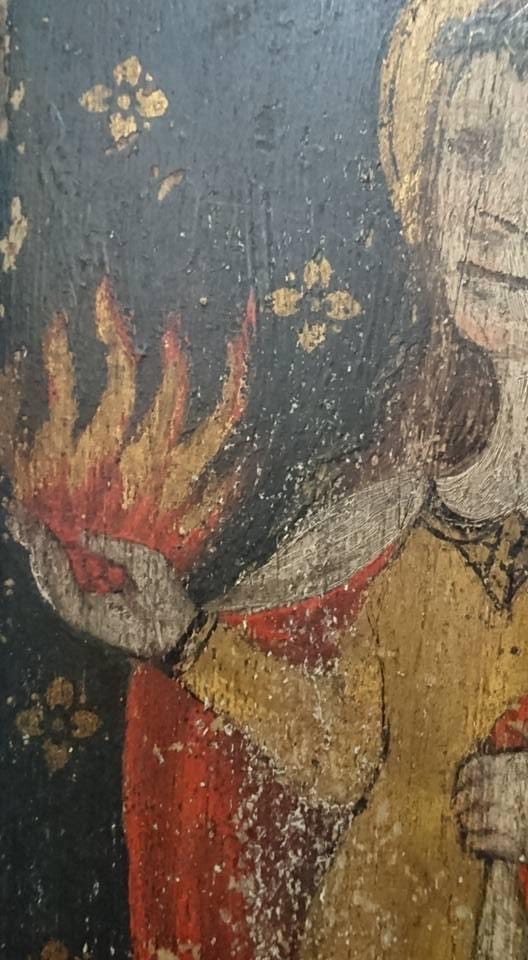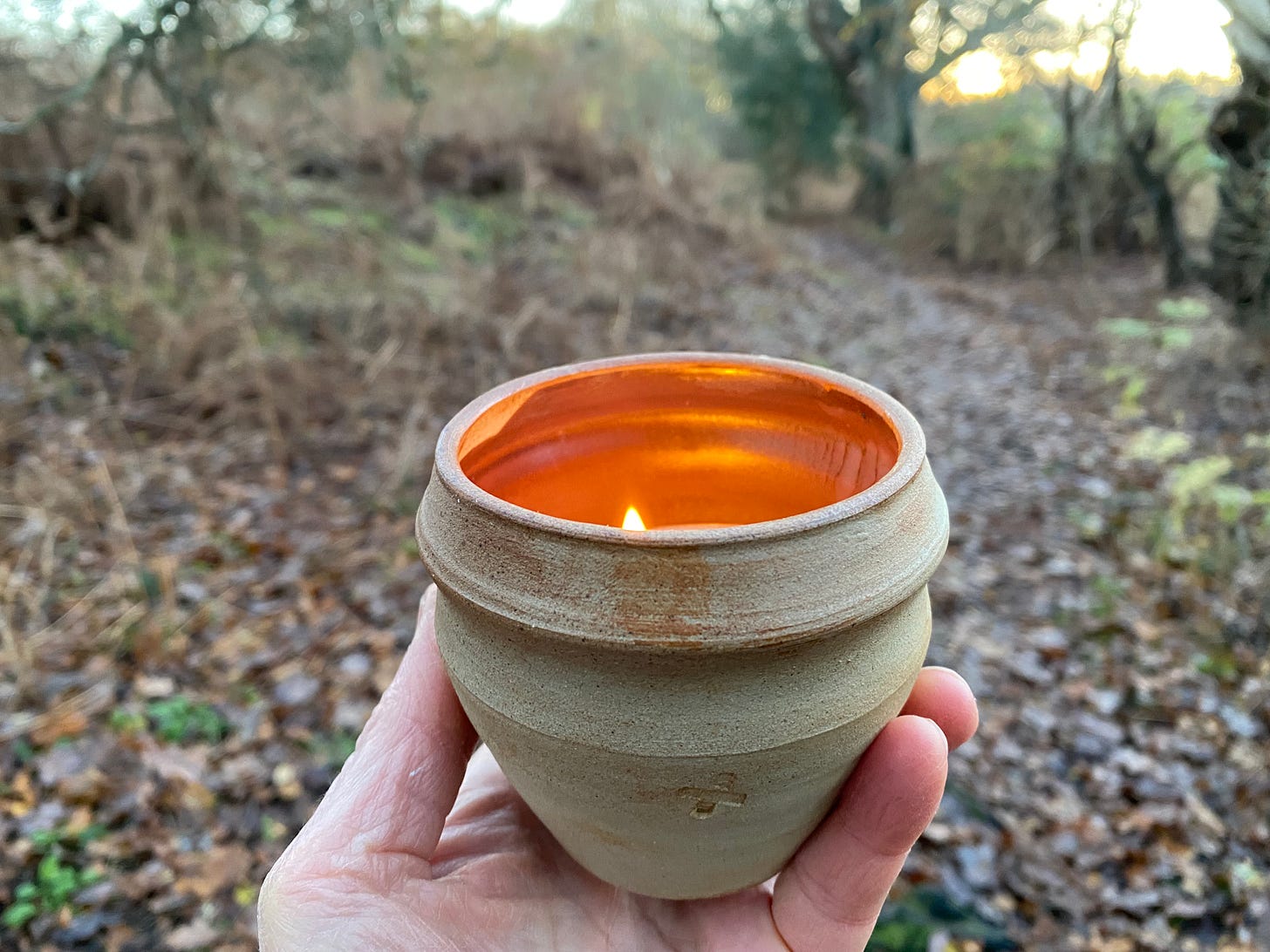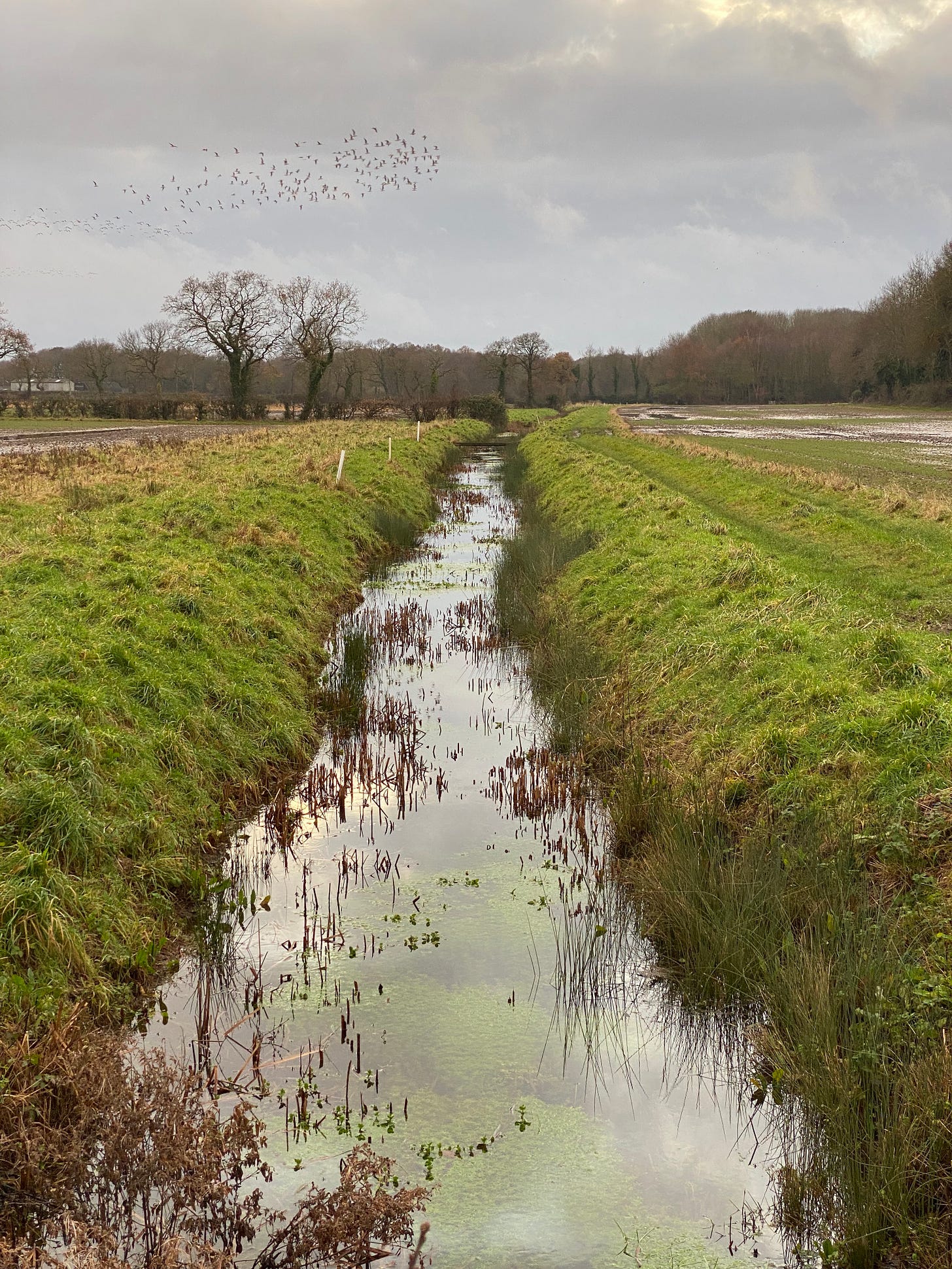He stood alone in a magic world. The candles waved in the air that was as much in movement as if in a forest. Every now and then a spindle of wax breaking off a guttering candle fell into the brass holder with a bell-like note that seemed to go up and up …
Lucy Boston, The Children of Green Knowe.
December sun in Acorn Wood.
Hello friends. A happy new moon AND St Lucy’s Tide greetings. I know that the moon was technically new on 12th here, so my apologies for being a little late. Indeed, next time you look up at the evening sky perhaps you’ll even glimpse the first slim crescent. I don’t know about you, but that’s when I really feel awed by the delicacy of its newness.
The words with which I’ve started this newsletter come from my favourite book, which just happens to be set in the days before Christmas and in a location where I have family connections. As with most books that jump into your heart as a child, The Children of Green Knowe will probably touch you more if, like me, you first read it at the age of seven or so. But even if it’s new to you, the writing is truly glorious and I couldn’t recommend it more. My edition is the original hardback but it’s been reprinted in paperback many times. Whenever I see a copy in a charity shop I buy it and try to spread the magic wherever it seems to be needed. I picked one up for £1 a couple of days ago.
Anyway, apart from waxing lyrical about the most magical tale ever, what else is in store in this edition of Bracken & Wrack?
On the Birch Track
Poetry by Hilary Llewellyn-Williams, Victor Tapner and Sarah Greaves
The Wild Edge of Winter
A St Lucy’s Eve Walk
The Scent of Saffron
December Weather Lore
St Lucy on the medieval rood screen of Stratton Strawless church, Norfolk.
On the Birch Track
This time two years ago I was up to my elbows in birch bark, wrapping my midwinter story-candles in recycled tissue paper stamped with stags, ivy, birch leaves, pine cones and snowflakes. Off they flew to their new homes, and whether Old Saint Nick was involved in their delivery is a matter between me and his reindeer messenger.
I have magical memories of exploring the Birch Track and bringing back its tales for us all to chat about over a steaming cuppa around our campfire in the clearing.
One favourite discovery was birch tar oil, which naturally asked to be included in the pure essential oil blend. I’d never used it before and somehow even just a few drops managed to fill the cottage with its addictive, smoky fragrance. All the more so when I tried a little too hard to pull off the resistant lid and ended up with half a bottle of it down my dress ;)
As St Lucy’s Day arrives again, colours soften and the wind grows keener. Most days I’m out in the birch woods and the memories return with a rush.
Here in north east Norfolk dusk falls very early now, with sunset around 3.40pm. Rather than trip over roots and briars, I carry a candle. The pottery vessel soon warms my chilly fingers as I clasp it around the fullness of its belly, its earthy crosses imprinting themselves onto my palms while its wood wick crackles.
A tiny fire to rouse the sun into returning once more and to see me through these quiet wintry days.
Down in the birch woods, the moon turns the trunks to gleaming silver and frosty bracken crunches under deer-hoof.
December birches on the edge of the heath.
The world has tilted far
from the sun, from colour and juice.
I am tired. I draw myself in
from what’s happening out there
in the rain’s ragged shadows.
I am waiting for a birth
that will change everything: the earth
born over and over;
the cold eye of light slowly widening -
these hard buds guarding our unopened time.
Hilary Llewellyn-Williams, ‘Elder’ (extract), The Tree Calendar
The Wild Edge of Winter
I’ve written before about St Lucy/Lucia and also about her wild counterpart, Lussi, and there’s a lot of other information out there too. Instead of adding more words to those already out there, I thought I’d share again ‘St Lucy and the Wild Edge of Winter’, which I hope, in its rambling way, gives just a taste of this liminal time.
‘St Lucy and the Wild Edge of Winter’, 15 December 2021.
Old Man Winter walks with snow-shod feet
Hangs hoar on the briar and whistles through the sleet;
Crackling fire without makes home-fire sing
Old Man Winter, Christmas he doth bring;
Early draws away the day
With fingers of frozen clay,
His glance the tender garden mars
His breath makes brilliant the stars.
Sarah Greaves
On St Lucy’s Eve 2023
Along the lane there’s that sweet scent of overblown berries and decaying leaves. It still smells like November, though there’s a tiny sharp edge now. Everything is collapsing. It’s easier now to see where fox, badger and muntjac cross and re-cross the lane between wood and heath, disappearing into thickets of bramble and bracken.
The tarmac is awash with mud, the many potholes and puddles reflecting an expanse of grey sky. Blackened clusters of sycamore keys swing grimly on the slenderest of strings. My trusty boots slosh through the mud unscathed, but the approach of any vehicle has me jumping onto the slippery bank and standing well back.
Towards the bottom of the lane, swathes of bracken stretch onto the heath. It’s more open here, so the fronds are still quite crisp and startlingly coppery. A sudden ripple, and a muntjac in its bark-brown winter coat swishes through. The muntjacs have quietly turned subtly drab, the colour of mud, twig and forest floor, slipping easily into a wintry palette. Elsewhere it’s every shade of honey. Palest clover for the lane-side stems, deepening to heather. Then darker still, the colour of molasses as leaves and bracken dissolve, seeping into the earth to nurture the trees as they sleep. I imagine the thick sweet syrup trickling deep between their roots, ready to be coaxed upwards by the returning light. Then, that same rich honey will swell the tightly-furled buds and pulse to the ends of the topmost twigs.
Every shade of honey, 12 December 2023: St Lucy’s Eve.
The Hundred Stream calls and I turn left at the end of the lane. It’s afternoon but not yet twilight; a flat shadowless light, the few remaining oak leaves showing their scalloped edges in sharp silhouette. That low darting shape must be a wren. Then I’m out of the trees, and fields lie on either side. Bare; furrowed and striped with sky. So much water lying there. I have a sense of floating between sky and sky.
Then I hear the gulls. Crowds of them, rising in flocks from the flooded fields. Their whiteness against the pale grey sky has always pulled me. When I lived in the city I adored the moment on the footbridge high above the unseeing cars when you drew level with the lone tower of St Benedict. Nave and chancel taken out by a WWII bomb, still the medieval tower sprang from the earth resplendent with its circling crown of gulls. Flint, sky, wings: all constantly changing places. Light against dark, dark against light. There’s something of that memory now, as the gulls wheel, rise, fall and turn above endless corrugations of earth and water. Air and fire too: a flicker of low sun snakes across the lengths of reflected sky, disturbed only by the faint shadows of massed wings.
The stream is a bright ribbon, a streak of silk. I like it because it’s clear and chill, flowing smoothly over bright green cushions just below the surface. I love knowing that it broadens and joins the canal, then the River Ant, then takes its course through Barton Broad and out again before angling into the Yare, bursting into the wild North Sea at Great Yarmouth.
Here it’s a baby, still wet behind the ears. I lean on the cold curve of the bridge rail, gazing at the place where it touches the horizon between stands of trees, their bare bones starkly meshed. Behind me a whirr, and the urgent throaty call of a pheasant is answered by another.
Linger a little longer and the ribbon would turn to satin, shot through with apricot, rose and lavender. But it’s time to turn back. It’s enough that wren, muntjac, pheasant and gull have shared their December afternoon with me. Not to mention myriad unseen eyes peeping from the edges.
Perhaps - who knows - even those of St Lucy herself, flashing fire.
The Hundred Stream and gulls, 12 December 2023.
The Scent of Saffron
St Lucy’s feast day always marks in my mind the beginning of Christmas. The beginning of Advent really, as I can never truly step into the season until St Lucy has walked among us in her simple white dress and with eyes aflame, offering us fire and hope.
While doing some research for an art performance piece eleven years ago, I came across several recipes for Lussekatter (Lucy Cats) traditional Swedish buns eaten on St Lucy/Lucia’s Day, and was intrigued by their folklore. Saffron turns them golden, and they are coiled into S-shaped sun-wheels, circling the Solstice. Each is impressed with two raisins, giving them ‘eyes’.
I had taken to enacting a version of the early-morning ritual for myself, by taking croissants and jam and coffee to have for breakfast in bed by candlelight on the morning of St Lucy’s Day. But last year for the first time, I managed to make the whole thing just a tiny bit more authentic by making my own Lucy Cats.
If I really wanted it to happen I was going to have to mix, knead and shape the Lussekatter on St Lucy’s Eve before going to bed, and leave them in the fridge overnight. Then I could come downstairs early to bake them ready to eat in bed, with hot fresh coffee, by candlelight before the dawn.
Realistically I would have to forgo the candle crown and long white dress, but I could still have the buns, and homemade blackberry jelly could substitute for the lingonberry jam I imagined being served with them.
When I took them out of the fridge I was disappointed to see that they hardly seemed to have risen at all. But sliding the tray into the oven had a wonderful effect, and as they only took about 8 minutes to bake I was literally watching them swell and turn golden brown before my eyes.
A couple of minutes’ cooling while I prepared the coffee and the long-held ambition became a reality.
The simplest of rituals. A flickering candle by the bed and a view of the big leafless oak as the light increased towards sunrise. The richness of strong coffee and the strange, sweet aroma of saffron. Just sitting there, cross legged, with the blanket pulled up warmly, sipping and reflecting for a few minutes before stepping into whatever the day might bring.
What the day brought was the iciest grip on the land I’ve known since I’ve been here. Thick hoar frost even at midday, each holly leaf rimmed around as if elves had been let loose with pritt stick and glitter. Too slippery in the lane for a St Lucy’s Day walk. Fresh water for the birds frozen almost as soon as I poured it into the enamel pan. The perfect sphere of a robin, fluffed up against the chill. Jack Frost decorating the van windows.
The rest of the Lussekatter safely in the freezer for sharing another day.
PS: There are lots of recipes for Lussekatter on the internet. I read on one of the Swedish sites that the buns are eaten in Sweden throughout Advent, not just on the feast day of Santa Lucia. So you still have plenty of time!
Lussekatter in the kitchen. 13 December 2022.
All night the hearth pot simmers
rush dips flicker
our dogs and old ones sleep by the low fire
Birch smoke seeps through the high thatch
loosening spiders and woodlice
Children stir under rug and pelt
Salt pork breathes in the willow racks
bowls of rough honey
tubs of mead
goat milk thickening to cheese
Cattle by the wall foul the straw
big warm bellies
teeth grinding
their slow steam rising
Water drips through an old roof stitch
Out in the pen
rain beats the ground like stoneshot
Victor Tapner, ‘Round House’, Flatlands
When the Moon Wears a Rusty Bonnet
Finally, some useful pieces of December weather lore. Just a small selection of those offered by the Victorian Yorkshire wise woman to whom we often turn for advice on these matters.
When in autumn and wintertime the sun is like a ruby in a betrothal ring, expect galloping winds from the north and north-west; and when in those seasons the sun in its rising is the colour of a deep-hued wine, you may expect similar ruffianly winds to come blustering from the south and south-east.
When in the wintertime the stars shine bright as new buttons, it will be champion weather next day; but if they’re dim and fogged over and flicker like jack o’ lanterns, you can be sure of rain and restlessness.
If in the autumn or the wintertime, or yet the early spring, you should see the beasts of the fields, the horses and the cattle, standing together in little bands and breathing the breath of each other, then you will know it’s bound to be a cold day and hoary, and you can expect no better for a short while at least.
When the moon wears a rusty bonnet, there’ll be rain clouds and fickle weather.
When a rooster crows in the rain, he’s crying ‘Sunshine - soon! Sunshine - soon!’
Until next time.
With love, Imogen x












I think Birch track is the one candle that I truly wish I’d bought. I love the ones I have of course, but this candle sounds just magic.
What a beautiful evening read. Everything is in its place and ready for midwinter. The book I heard on Audible on your recommendation it was magical
Dear Imogen you weave a winter’s tale for us to enjoy Thank you xx